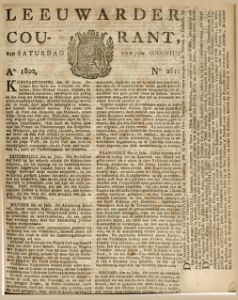About the day » Saturday August 7, 1802Calender converter
Born on Saturday August 7, 1802
- Adrianus Johannes van der Palm, Rotterdam († 1802)
- Aafke Minnes van HELDER, Sleat, De Fryske Marren, Fryslân, Netherlands
- Amélie Antoinette Victorine de Broglie, château de Rasnes († 1855)
- Annigje Stam, Nw-Lekkerland († 1887)
- Antje Jans Ris, West-Knollendam, Noord-Holland, Nederland († 1861)
- Albert Reinders Gorter, Zwartsluis († 1842)
- Agnes GIELEN, Helden, Limburg, Netherlands († 1839)
- Anna Mary Miller, Northampton, Pennsylvania, United States († 1886)
- Anna Barbara Beuth, Born
- Albert Gorter, Zwartsluis († 1842)
Died on Saturday August 7, 1802
- Eva Lambertus Clessens (75), Middelbeers
- Bryan FAIRFAX (66), Mount Eagle, Fairfax Co. Virginia, Verenigde Staten
- Antje Symons
- Augustinus VERNIERS, Destelbergen
- Cornelis Cornelisz Duijvenbode (84), Katwijk aan Zee
- Anna Bijnen (45), Waalre, Noord-Brabant, Nederland
- Cornelis Duijvenbode (84), Katwijk aan Zee, Nederland
- Cathrine Charlotte Kesselring (1), Herford, Nordrhein-Westfalen, Duitsland
- Arjen Klazes Wassenaar (31), St. Annaparochie
- Jannetje Kooij (1), Krimpen aan de Lek, Zuid-Holland, Nederland
Source: Delpher (KB | national library) Newspapers from August 7, 1802 at Delpher
Born on August 7
- 1742 » Nathanael Greene, American general († 1786)
- 1751 » Wilhelmina of Prussia, Princess of Orange († 1820)
- 1779 » Carl Ritter, German geographer and academic († 1859)
- 1844 » Auguste Michel-Lévy, French geologist and author († 1911)
- 1860 » Alan Leo, English astrologer and author († 1917)
- 1862 » Henri Le Sidaner, French painter († 1939)
- 1862 » Victoria of Baden († 1931)
- 1867 » Emil Nolde, Danish-German painter and illustrator († 1956)
- 1868 » Huntley Wright, English actor († 1941)
- 1868 » Ladislaus Bortkiewicz, Russian-German economist and statistician († 1931)
Died on August 7
- 1787 » Francis Blackburne, English Anglican churchman and activist (b. 1705)
- 1817 » Pierre Samuel du Pont de Nemours, French economist and politician (b. 1739)
- 1834 » Joseph Marie Jacquard, French weaver and inventor, invented the Jacquard loom (b. 1752)
- 1848 » Jöns Jacob Berzelius, Swedish chemist and academic (b. 1779)
- 1855 » Mariano Arista, Mexican general and politician, 19th President of Mexico (b. 1802)
- 1864 » Li Xiucheng, Chinese field marshal (b. 1823)
- 1893 » Alfredo Catalani, Italian composer and academic (b. 1854)
- 1899 » Jacob Maris, Dutch painter and educator (b. 1837)
- 1900 » Wilhelm Liebknecht, German lawyer and politician (b. 1826)
- 1912 » François-Alphonse Forel, Swiss limnologist and academic (b. 1841)
Names that were popular for boys in 1802
- Jan
- Johannes
- Hendrik
- Cornelis
- Pieter
- Willem
- Jacob
- Joannes
- Gerrit
- Petrus
- Jacobus
- Dirk
- Adrianus
- Jean
- Klaas
- Leendert
Names that were popular for girls in 1802
- Maria
- Anna
- Johanna
- Cornelia
- Elisabeth
- Catharina
- Joanna
- Grietje
- Aaltje
- Trijntje
- Adriana
- Marie
- Neeltje
- Antje
- Elizabeth
- Jannetje
Source: Wikipedia Historical events 1802
- This page is only available in Dutch.De Republiek der Verenigde Nederlanden werd in 1794-1795 door de Fransen veroverd onder leiding van bevelhebber Charles Pichegru (geholpen door de Nederlander Herman Willem Daendels); de verovering werd vergemakkelijkt door het dichtvriezen van de Waterlinie; Willem V moest op 18 januari 1795 uitwijken naar Engeland (en van daaruit in 1801 naar Duitsland); de patriotten namen de macht over van de aristocratische regenten en proclameerden de Bataafsche Republiek; op 16 mei 1795 werd het Haags Verdrag gesloten, waarmee ons land een vazalstaat werd van Frankrijk; in 3.1796 kwam er een Nationale Vergadering; in 1798 pleegde Daendels een staatsgreep, die de unitarissen aan de macht bracht; er kwam een nieuwe grondwet, die een Vertegenwoordigend Lichaam (met een Eerste en Tweede Kamer) instelde en als regering een Directoire; in 1799 sloeg Daendels bij Castricum een Brits-Russische invasie af; in 1801 kwam er een nieuwe grondwet; bij de Vrede van Amiens (1802) kreeg ons land van Engeland zijn koloniën terug (behalve Ceylon); na de grondwetswijziging van 1805 kwam er een raadpensionaris als eenhoofdig gezag, namelijk Rutger Jan Schimmelpenninck (van 31 oktober 1761 tot 25 maart 1825).
- March 16 » The Army Corps of Engineers is established to found and operate the United States Military Academy at West Point.
- April 21 » Twelve thousand Wahhabis under Abdul-Aziz bin Muhammad, invaded city of Karbala, killed over three thousand inhabitants, and sacked the city.
- May 19 » Napoleon Bonaparte founds the Legion of Honour.
- May 20 » By the Law of 20 May 1802, Napoleon Bonaparte reinstates slavery in the French colonies, revoking its abolition in the French Revolution.
- May 28 » In Guadeloupe, 400 rebellious slaves, led by Louis Delgrès, blow themselves up rather than submit to Napoleon's troops.
- September 3 » William Wordsworth composes the sonnet "Composed upon Westminster Bridge, September 3, 1802".
Weather August 7, 1802
The temperature on August 7, 1802 was about 18.0 °C. Wind direction mainly west-southwest. Weather type: omtrent helder.

 August 6, 1802
August 6, 1802